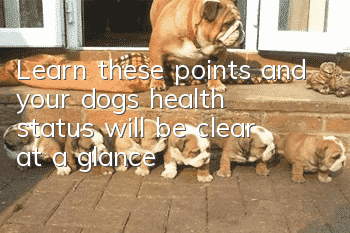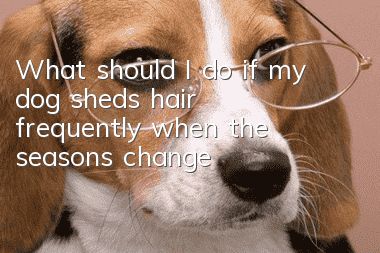Learn these points and your dog’s health status will be clear at a glance

For dog owners, the health of their dogs is of vital importance. But I’m afraid that if I don’t discover it in time, I’ll miss the best opportunity for treatment.
But friends, don’t worry, if you master the following moves, you will have a basic understanding of the dog’s physical condition!
A sound mental outlook
The healthy mental outlook of a puppy includes being lively and active, curious about moving objects, and having a desire to explore, etc., but at the same time, it is also allowed to show fear when facing unknown objects.
For example: trembling, dodging, barking, etc. On the contrary, if the dog does not respond to changes in the outside world, it is mostly regarded as the state of an unhealthy dog.
Facial features and their secretions
Check the skin condition inside the dog’s ears:
A healthy dog’s ear canal should be clean and warm. If you find that your dog's ears have a peculiar smell, are red, swollen, bleeding, or have unknown dark attachments, it means that there may be damage or parasites in the inner ear.
Check the dog’s mouth and oral condition:
A healthy dog has white teeth, pink gums, no bad breath, and no other secretions except saliva.
If you find odor, unknown secretions in your mouth, or pale gums or damaged teeth, it may be due to dietary problems, gum disease, nutritional deficiencies or even anemia.
Touch the dog’s nose:
A healthy dog's nose is slightly moist, and your hands will feel wet after touching it (the nose of a dog that has just woken up will be dry). If there is nasal discharge, it should be clear and transparent.
If you find that your dog’s nose is dry or even cracked, or there is thick yellow mucus, it indicates that your dog’s physical condition is not optimistic, and it may be a sign of fever or respiratory disease.
The color of the nose varies among different breeds and is not necessarily related to health status.
Check your dog’s eyes
For purebred dogs, different breeds have clear requirements for the shape, position, and iris color of their eyes, but this is not absolutely related to the dog's personality and health.
When choosing a pet, pay attention to whether the eyes are clean, whether they can be fully closed or opened, whether there is inflammation of the iris, and the color and amount of eye droppings.
If you find that your eyes are bloodshot, there is flesh protruding from the corners of your eyes, or there is too much eye droppings, these are not good signs. In addition, some breeds, such as Chow Chow, are prone toIf you have trichiasis or eyelid inversion or inversion, you should also pay attention to the examination.
Check your dog’s five senses
Check the dog's resistance to external pressure by touching and slowly increasing the intensity of kneading the skin of the dog's feet. Dogs with higher resistance will be more likely to accept being restrained by collars and leashes in the future.
Squeeze the sound toy behind the puppy and observe the puppy's performance. Generally, the dog will actively observe and look for the source of the sound. If the dog is timid, it will show fear. However, if the dog does not respond at all, it is necessary to find a veterinarian to check whether it has any symptoms. Possibility of deafness.
Use balloons or toys to shake in front of puppies. Dogs with normal vision will show curiosity, follow the object and shift their eyes, or show fear.
Check the condition of the dog’s coat and skin
The state of a dog’s coat is directly related to its diet. Regardless of the different coat feel of different breeds, a healthy dog's coat should look shiny, not messy, and not dry.
· Use a needle comb with dense needle teeth to comb the dog's coat and check whether there is any dirt falling off. An unbalanced diet or the use of inappropriate bath products will increase the dog's dandruff. Then separate the dog's coat and check Skin conditions.
· A healthy dog’s skin is light pink with no obvious discoloration, and there should be no visible black spots at the hair roots (which may be parasites).
· Focus on checking the skin around the mouth, neck, abdomen, limbs, armpits, and anus to see if there are flaky or lumpy discolorations. If so, it may be a sign of fungal or mite infection.
Check your dog’s excrement
Excretion is the most direct reflection of the dog’s health. The excrement of a healthy dog should be soft and shaped, mostly brown or yellow (the color of the feces has a lot to do with the ingredients, so different colors will appear in specific cases).
If you find that your dog’s feces is shapeless, muddy, spherical, or even watery, or if your dog’s feces is red, gray-white, or black, it may be a sign of digestive tract disease or low immunity.
Checking whether the area around the anus is clean can also tell you about your dog’s health. A healthy dog's anus should be clean, the skin should not be red or swollen, the coat around the anus should not be dry, and there should be no fecal residue. If you find that the hair around the anus is stained with feces, it at least proves that your dog has diarrhea.
Check the dog’s athletic ability
Let the dog walk and run on flat ground to check the coordination of its limbs. For a period of time after a puppy is born, its muscles and bones are not fully developed, and it is normal for puppies to have imbalances when walking or running.
This state should not occur frequently by the time it is three months old. At this time, if the dog still has difficulty moving, limp, and falls easily, it may be injured or brain damaged.
- What are the symptoms of dog enteritis?
- How to tell if a Corgi is pure or not?
- How to prevent dogs from frequently shedding and losing hair?
- The dog suddenly doesn’t dare to put one foot on the ground
- What should I do if my dog vomits after eating?
- What are the deworming drugs for pets?
- Six steps to bathing a small dog
- What is the sequence of training subjects for horses and dogs? You will know after reading this!
- How to train Teddy not to get his hands bitten? Finally found the trick!
- Can dogs with parvovirus infect humans? How to treat and prevent it?



